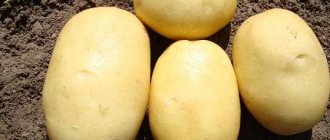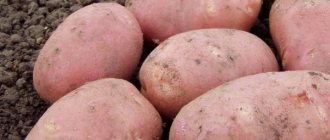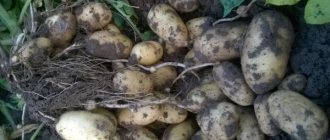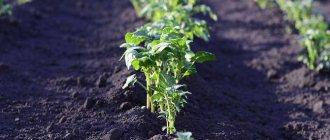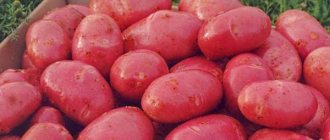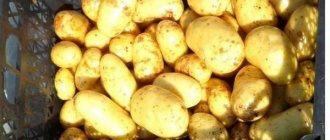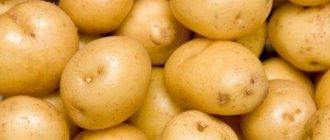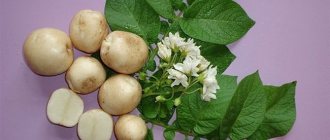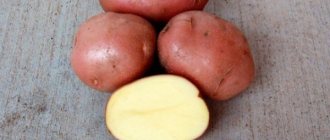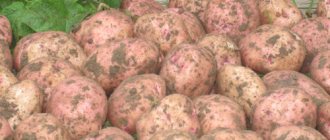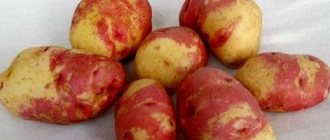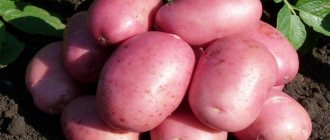Characteristics
Among the main features of the mid-early table potato variety Jelly, commodity producers highlight decent yield. If the summer was characterized by stable weather, the owner was not too lazy to bow down during hilling and weeding, did not spare the organic matter, and the soil was to the liking of the potatoes, you can harvest up to half a ton.
The second important feature is keeping quality, which when translated into numbers is 86%. In good conditions, root vegetables do not lose their presentation and taste for a long period.
The main criterion for their safety is the temperature regime: in storage the thermometer should not fall below +2…+4°C. The zero mark will trigger the transition of starch into sugar. Tubers that have lost their shape and taste are not suitable for consumption.
Consumers note the nutritional value of the tubers, lack of wateriness and creamy taste. Root vegetables do not darken or become overcooked during processing.
Taste qualities
The “Jellie” variety has dense pulp, so it does not boil soft or change color during cooking. Even new potatoes no longer have wateriness. Tubers are highly nutritious due to the content of useful substances - protein, vitamins and microelements. "Jelly" is called the vitamin variety.
The pleasant taste and quality of potatoes allow the variety to be used for preparing first and second courses, chips or fries. But to get puree, you will need to use a blender. The reason is the low level of starch content, which for this variety is 14% - 18%, as well as the density of the tubers. Because of this, the potatoes have an average degree of boiling, and preparing a tasty Jelly puree is a little more difficult than a flavorful soup.
Landing rules
Preparations for planting Jelly potatoes begin in the fall. Before digging up the soil, humus (5 kg), superphosphate (30 g), and potassium sulfate (20) are added to each m2. After the fertilizers are scattered over the site, the soil is dug up. Add sand or peat to heavy soil at the rate of one bucket per m2. At the same time, seed material is prepared, selecting strong tubers from the newly harvested crop.
In the spring, the ground is dug up again, adding potassium, nitrogen and phosphorus fertilizers. Ash or manure is useful as fertilizing, but only rotted manure. Fresh manure contains a lot of harmful larvae and nitrogen. Spring digging should be deep. In the process, site owners remove weeds and old roots that can cause disease.
- About a month before planting, root vegetables begin to be prepared. Seed material selected in the fall is inspected again, damaged specimens are removed, and then the remaining specimens are exposed to direct sunlight.
- After 10-14 days, when the tubers turn green (signal from solanine), they are placed in boxes, covered with thick polyethylene with holes made in them, and left for germination.
- As soon as the sprouts on the tubers grow to 1.5-2 cm, the potatoes are cut into pieces so that each of them has eyes. Now you need to dry the cuts, otherwise the seed material may rot in the ground. This will take about another week.
- Just before planting, the seeds are kept in a pale solution of potassium permanganate for disinfection. Some farmers treat tubers with growth stimulants.
- The seeds are placed in the holes with their eyes facing up.
- Jelly potatoes should be planted when the ground has warmed to 7-8°C and there is no danger of frost returning.
- Experienced gardeners know that the planting area should be open and well lit.
- Potato rows are arranged from north to south. Jelly potatoes are not picky about soil quality, but they will be most comfortable on loam or sandy loam.
- The distance between the ridges, taking into account the spreading nature of the bushes, should be at least 70-80 cm. Between the bushes - 35 cm.
- To repel pests, it is recommended to add onion peels to each hole.
Characteristics of seed potatoes "Jellie"
For planting, high-quality seed material is required. Main valuable characteristics of Jelly potatoes »:
- Excellent storage performance. The germination capacity of seed potatoes is maintained for several seasons. This is due to the pronounced dormant period of the variety. Of course, provided that the tubers for planting are carefully selected and stored in suitable conditions.
- No degeneracy of the variety. There is no need to constantly update seed material. Seed tubers "Jelly" can be selected annually from the site and planted the following season, observing crop rotation.
- High percentage of germination. Varietal potatoes “Jellie” produce full-fledged sprouts not only on whole tubers, but also on parts. This significantly saves planting material.
To ensure that the quality of the harvest remains at a high level, vegetable growers competently prepare the seeds.
The first important stage is the selection of potatoes for the next planting. From the resulting harvest, undamaged healthy medium-sized tubers are selected and stored. Seed material is stored well if the crop is harvested in sunny, dry weather, and then dried under a canopy for a week.
Storage conditions are the second important criterion for planting potatoes. When optimal conditions are provided, 87% of tubers retain their full characteristics. The Jelly variety requires room ventilation and regular monitoring of humidity and air temperature. The main indicators are maintained in the ranges - humidity 85% - 90%, temperature +2°C - + 5°C. At the same time, the taste, appearance of potatoes, and other quality characteristics do not change. Seed material is stored separately from tubers set aside for consumption.
Features of care
There are no distinctive points in caring for Jelly potatoes: everything is carried out according to the classical principle. And this is also a plus, according to gardeners. A good bonus is that Jelly potatoes, despite their exotic name, are quite unpretentious. If you just close your eyes to regular hilling. But there’s no escape from this; for everything good you have to pay for it somehow.
- In the first days after planting, Jelly potatoes need to be harrowed. This will reduce the number of weeds that appear before the potatoes.
- As soon as the first shoots emerge, the soil needs to be loosened to remove the crust. This will allow oxygen to reach the very roots. The second hilling is carried out as soon as the buds appear.
- If there is a threat of frost returning, you need to sprinkle the seedlings with soil.
- Hilling of Jelly potatoes, taking into account the timing of their ripening, should be high - for better formation of stolons, on which the number of tubers in each nest depends.
- Gardeners should not forget about loosening and weeding.
- Early loosening is carried out with a rake or hoe. Deep loosening is done in rows and between rows as soon as the potato seedlings grow.
- Jelly potatoes do not tolerate heat well. Mulching can save you from this scourge.
- But moisture can also undermine the health of the plant. You don’t need to water often, only when necessary. Withered leaves will become a beacon. During flowering and bud formation, watering is necessary.
Description
To understand what Jelly potatoes are, it is worth studying the description of the variety, photos and reviews.
This one produces a harvest 3 months after planting. Up to 15 fruits are formed on one bush. The weight of a potato is 100 grams. The tubers are of the same shape, with a pleasant golden hue. They have no eyes and rarely darken. The pulp of the culture is dark yellow. After heat treatment, potatoes do not darken or become boiled.
The bush can be tall or medium in size, the tops are very spreading. There is little green mass. The leaves are slightly wavy, large, dark green in color. When flowering, large white flowers grow. Few berries are produced.
Cleaning and storage
Harvesting of Jelly potatoes begins in September. The signal to start harvesting will be the yellowed leaves of the plant. A week before harvesting, all tops must be mowed. During this time, the potato peel will become rougher and less responsive to mechanical damage.
- Jelly potatoes are harvested with pitchforks, shovels, and on large areas with combines.
- The dug up potatoes are dried under a canopy, laid out on old bags or cloth.
- Then the root crops are sorted, removing green and rotten ones.
- At the same time, seed material is selected. There is no need to throw away green potato tubers; they will be useful for the next season, but keep them, like all seeds, separately.
During storage, Jelly potatoes require periodic inventory. When sorting through tubers, rotten or sprouted ones must be removed. Keep Jelly potatoes in bags, nets or boxes. There is an opinion that for better preservation in the very first days, potatoes need to be “hardened”. For this purpose, the temperature in the basement or vegetable storehouse is lowered by 0.5 degrees every day, gradually bringing it to the desired level. This procedure can take 2 weeks.
In spring, it is recommended to regularly ventilate the room where Jelly potatoes are stored. This is usually done in the morning and evening hours.
Growing
The Jelly variety is a mid-early variety, so the first digging can be done already in mid-summer. To achieve earlier fruit ripening, you can plant sprouted potatoes.
Seed preparation
Seed material is prepared approximately a month and a half before planting. First, the potatoes are placed in a warm place to “green” them. Under the right conditions, potatoes' eyes wake up within a week. After 14 days, the first shoots will appear, which by the time of planting will grow by 2 centimeters. If there are few seeds, large specimens are first cut into several parts and also allowed to germinate.
Before planting, the seeds are soaked in manganese for disinfection. You can also treat the tubers with growth-stimulating drugs.
Landing
Potatoes of this variety love light loamy soils, well drained and fertilized. Potatoes begin to be planted when the weather becomes warm and dry. The soil temperature should be at least 8 degrees. Since Jelly belongs to the group of mid-early varieties, it needs to be planted a little earlier than other species. Therefore, to plant potatoes, you need to use the most open areas that open from the snow earlier than anyone else. It is better that the soil is low acidic or contains a neutral amount of pH (optimal acidity for the variety is 5.0-5.5 percent)
Advice: Before planting, you need to dig the ground deeply, removing from it tubers and plant remains forgotten from last year. This will help reduce the chances of developing new diseases.
It is better to grow potatoes locally after crops such as beets, cabbage, cucumbers and greens.
Can be planted in the traditional way in rows or holes. The material is placed in the ground with the eyes facing up. It is necessary to maintain the correct distance between future bushes, as they grow large and powerful. Each of them needs enough space for proper nutrition and growth. Therefore, the tubers are placed at least 40 centimeters from each other. The row spacing is 85 centimeters.
We must not forget about fertilizers, the benefit of which comes down to the correct formation of bushes and ovaries. Before planting, add compost or manure to the ground. It is better not to use fresh manure, as it can make the tubers sick, and the taste of the potatoes changes. In addition to organic matter, mineral fertilizers are also used. This can be a mixture of urea, superphosphate, potassium sulfate. You can buy a ready-made mixture, for example Kemira. Adding ash will help disinfect the soil from the appearance of various diseases. And the presence of onion peels in the holes will repel pests from the tubers.
Fact: Jelly has a high germination rate. Sprouts appear evenly, tubers set quickly.
Plantings need to be harrowed in the first days, even if seedlings have not yet appeared. This can destroy young weeds that hatch through the ground faster than potatoes. With the appearance of the first sprouts, the ground around them needs to be loosened in order to shake up the soil and remove the resulting crust. This technique can enrich the soil with oxygen, which in turn is necessary for the development of potato roots.
Fact: Jelly grows well in fertile soil with plenty of sand.
If potatoes were planted early, it is possible that frosts are possible at night. You can protect young plants by lightly hilling the shoots. Don't be afraid to cover them with soil, at least this way they will be reliably protected from hypothermia.
You may be interested in: Dates for planting potatoes in May-June 2021 according to the lunar planting calendar Favorable days for planting potatoes in 2021 according to the lunar calendar Dates for planting potatoes in 2021 for central Russia and the Moscow region
Care
The variety is unpretentious in care. To get a good harvest, the gardener only needs to pay attention to the potato bushes in a timely manner and regularly process the bushes.
In addition to typical crop care techniques, for healthy potato growth you also need:
- fertilize the soil with half-baked organic matter;
- carry out regular hilling. It is better to carry out the first procedure when the height of the bushes reaches 20 centimeters. At the time of the first shoots, you can prick up the sprouts if night frosts are approaching. This way you can protect young plants from freezing;
- It is better to do the hilling high in order to stimulate the growth of stolons, which in turn will produce as many formed tubers as possible;
- loosening must be done deeply, since the variety is considered early, so the plant should grow faster;
- There is no need to constantly water potatoes, as the variety is drought-resistant. Watering is necessary only in hot weather, as well as during flowering and budding. During watering, you can feed the bushes;
- Only one feeding is recommended for the entire season.
Mulching protects plants well from waterlogging and drought. Green manure can be used as bedding. It is especially recommended to use mustard, as it repels such a parasite as wireworms. Green manure helps provide plants with additional nutrition. If you use green manure wisely, you can avoid many stages of caring for potatoes.
Fact: the use of green manure helps to obtain a higher yield.
Ways to increase yield:
- Fertilizers should be added as needed. It is better to apply root dressing 1-2 times throughout the season. If the land has been well fertilized since the fall, then while growing the crop it is enough to feed it once. The main elements for potato growth are nitrogen, potassium, phosphorus, magnesium, calcium, copper.
- The taste of potatoes depends on the saturation of the tubers with oxygen. Therefore, it is so important to constantly provide the bushes with air. For better permeability, sand and increased doses of compost are added to the soil, regular loosening is done and potatoes are planted sparingly.
- Over-wetting the soil increases the risk of developing fungal diseases and generally reduces the quality of the crop. Adding sand will help the soil absorb water better. Digging up the area in the spring to ventilate the soil also helps. If groundwater is close to the surface, potatoes should be planted in beds up to 20 centimeters high.
Diseases and pests
Over the years, Jelly potatoes have demonstrated resistance to many diseases. Among them:
- potato cancer;
- rhizoctoniasis;
- golden nematode.
What the Jelly variety cannot cope with on its own is late blight. Moreover, it affects not only potato leaves, on which brown spots appear at this time, but also tubers. The disease can be triggered by rainy summers, excessively frequent watering, and the presence of weeds with viruses in the ground.
Here you need to remember the green tubers for planting. Solanine will help cope with many ailments, including late blight. What to do if Jelly potatoes get sick? Act, and act immediately.
- As soon as traces of late blight are found, the plant must be sprayed with preparations containing copper. The procedure can be repeated up to three times. 3 weeks before harvest, spraying with substances containing toxins should be stopped.
- Jelly potatoes are loved not only by people; Colorado beetles, click beetle larvae, and wireworms enjoy gnawing on them. The first is handled manually. If there are few hands, use special insecticides.
- Preventive measures that are carried out before planting and during plant growth will help defeat wireworms and click beetles: clearing the soil of weeds and proper care. If this does not work, buy fumigators.
How to care for the variety
Care includes traditional activities typical for any potato variety. Jelly is unpretentious and needs only basic agrotechnical procedures.
Watering
Jelly is a drought-resistant variety. Potatoes need watering in dry, hot summers, as well as during flowering and budding. Watering can be carried out simultaneously with fertilizing so that nutrients penetrate deeper into the soil.
Excessive moisture leads to the development of fungal infections and reduces the quality of the crop. If the summer is rainy, it is recommended to add sand to the soil and loosen it more often. If groundwater is close, potatoes are planted on high (up to 20 cm) ridges.
Fertilizers
The soil must be well fertilized before planting and contain the necessary nutritional components. During the growth period, Jelly potatoes are fed three times:
- at the beginning of growth - nitrogen compounds;
- during the period of flowering and budding, fertilizers with potassium are applied;
- For the formation of tubers, phosphorus compounds are needed.
See also
Features and rules for growing potatoes using Dutch technology
Read
During the growth process, it is not forbidden to use organic mixtures or complex fertilizers.
Advice! You should not overfeed potatoes. This changes the duration of the growing season and affects the taste of the tubers.
In winter, they are stored much worse.
Pest treatment
On small plantations, the Colorado potato beetle is disposed of mechanically, by shaking off the larvae into a bucket, and collecting the beetles by hand. If the planting areas are large, then treatment with pesticides is necessary - insecticides, the choice of which is quite large. At the first signs of late blight infection (the appearance of spots on the leaves), use copper oxychloride, Oxyx, Arcedil, based on the instructions. If late blight remains on the leaves before harvesting, they are mowed down, removed from the site and burned. The tubers are left in the ground for another 2 weeks so that they develop a thick skin.
The Jelly variety is resistant to many diseases. It is not affected by potato cancer, golden nematode, common scab, blackleg, or viral infections.
Loosening and mulching the soil
Mulching saves Jelly potatoes from drought and waterlogging. Ideal mulching materials include green manure, which can be sown between rows of nightshade crops. Mustard, for example, repels wireworms well, and phacelia supplies the tubers with additional nutrition. With proper planting of green manure, caring for Jelly is noticeably easier.
Loosening is necessary to provide oxygen access to the roots. Loosening is usually combined with hilling, which is carried out in two steps. The soil can be loosened to a considerable depth, since the roots lie deep. For better permeability, peat or sand and compost are added to the soil composition. The bushes are planted according to a scheme so that everyone has enough moisture, air, and sun.
Advantages and disadvantages
Among the features that give reason to recognize Jelly potatoes as one of the best varieties, experts call:
- High yield.
- Taste qualities.
- Resistant to long-distance transportation and mechanical damage.
- Suitable for cultivation for industrial purposes.
- Resistance to temperature changes and short-term drought.
- Immunity to some classic potato diseases.
There are disadvantages that you need to know about before choosing the mid-early Jelly potato variety:
- Requirement for complex mineral fertilizers.
- The need for periodic hilling.
- Lack of immunity to late blight.
Advantages and disadvantages
Jelly potatoes are not afraid of either heat or drought, so they can be safely chosen for growing in arid regions. Its advantages also include:
- Unpretentiousness. The culture can grow in any soil. Of course, if it is grown on good soil, the harvest will be richer. However, even on heavy soils it will not show poor results.
- Transportability. Jelly has a dense and thick skin that protects the pulp from damage.
- Excellent presentation. All tubers are beautiful and have approximately the same size, so they are readily bought at the market.
- Stability. There are varieties that gradually degenerate. However, Jelly is not one of those. It can be used as planting material from year to year.
- High nutritional value. Jelly fruits contain a huge amount of vitamins and minerals.
Among the disadvantages of Jelly is low resistance to late blight. Moreover, if an infection occurs, it affects both the tubers and the above-ground part of the plant. To prevent yields from decreasing, the crop must be planted in a new location every 3 years. This may not be entirely convenient for summer residents who have a small plot of land.
Attention!
The shelf life of potatoes is not bad (85%), however, in this it is inferior to many other varieties (usually reaching 99%).
Reviews
“We harvest the Jelly variety in the fall, but we start digging in early June. We are looking forward to the new potatoes. We bake it in the fire, and in winter we fry it and put it in soups. The puree from it is not very good, there are other potatoes for that. Although Jelly potatoes are called productive, I would argue that there are more worthy varieties. But as for care, storage and keeping quality, I would give it a solid five. We spent the winter with him three times - no worries or problems. There is no such thing as decay, it can shrink,” Angelina Grishkina, Tula
“We have been growing Jelly potatoes for 10 years. Good care, and this comes with experience, gives excellent results. Don’t forget to change the areas for sowing from time to time, choosing the right predecessors: green manure, onions, carrots, legumes. We appreciate the Jelly variety for its taste,” - Inna and Victor Gudimov, Kalyazin
Planting and growing potato varieties
The procedures for planting and growing Jelly potatoes are not much different from similar measures used for other varieties, but there are still some nuances.
Optimal timing
The timing of planting potatoes depends on the specific region. The following rule will help to calculate them more accurately: Jelly should be planted when the soil warms up to +8°C...+10°C, to a depth of 12 cm.
Important! Jelly potatoes, planted as early as possible (the substrate must be sufficiently warm), yield 1/3 more yield compared to tubers planted later.
Crop rotation rules
The rules of crop rotation for Jelly, as for other potato varieties, are simple.
- The culture feels good after:
- pumpkin;
- phacelia;
- turnips;
- carrots;
- legumes;
- onions and garlic.
- It is acceptable to grow after the following crops:
- cabbage;
- beet;
- dill;
- parsley.
- But after the following vegetables, potatoes should not be planted:
- tomatoes;
- pepper;
- eggplant.
Soil requirements
The most acceptable soil type for this variety is light sandy loam.
Preparation of planting material
15–20 days before the expected planting date, it is necessary to remove planting material from the storage location (if any); if it is not there, purchase tubers for planting. It is best to take them out into the sun and let them turn green. When the eyes come to life a little, large tubers can be cut into pieces; the variety responds normally to such procedures. You just need to look carefully to ensure that each piece of tuber has at least one eye. It would be a good idea to lightly cover the cut areas on the tubers with ash. This operation performs the function of protection and feeding.
Landing technology
Before planting potatoes, you should treat the future growing area with a cultivator and remove all excess from the soil (remnants of previous plantings). Then the substrate should be fertilized with potassium and magnesium sulfate, as well as superphosphate. The Jelly planting scheme is as follows: row spacing is 0.75–0.8 m, distance between tubers is 0.35–0.4 m. Denser planting of potatoes leads to a decrease in yield and the appearance of diseases due to lack of aeration and ultraviolet radiation. The tuber must be buried 9–12 cm into the soil.
Did you know? Since potatoes tolerate various processing methods well, over two thousand dishes can be prepared from them.
Advice from experienced gardeners and reviews about the Jelly variety
Many summer residents who grew the Jelly variety on their plot note the excellent taste of the potatoes, as well as a stable, large harvest. But some people didn’t like that Jelly tubers were hard and didn’t cook well.
Evgeniy, Nizhnekamsk : “The variety is not bad, the yield is high. But I personally don’t like hard and poorly cooked tubers.”
Ruslan, Saransk: “Jellie pleased me with its excellent taste. However, some bushes have been affected by late blight, so I advise you to plant it in dry places with deep groundwater.”
Marina, Salavat: “Even though the variety is called productive, I would argue with that. But as far as care, storage and keeping quality are concerned, this is a solid five. It's great for winter storage."
Potato planting process
Planting of Jelly potatoes traditionally occurs in the spring (a detailed step-by-step description of the process can easily be found on any gardening website). It is important to maintain the distance between the rows in order to then give space for the bush to grow, no less than 74 centimeters. Planting should be done in good weather conditions, because if the weather is rainy, this can also negatively affect further growth.
The bush needs a lot of space
The planting process for potatoes of any variety is similar. Both seed preparation and land cultivation. It stands out only in that for each species you need to maintain its own distance, depending on the latitude of the bush. Jelly potatoes need a lot of space to develop later.
